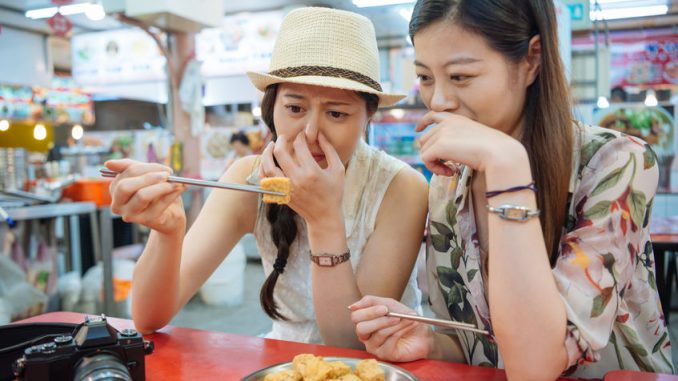
Stinky tofu might not be top of the list for many in terms of palatable foods but there is a continuing interest in overtly smelly foods. This stinky tofu is a food for those long Asian nights where it can be found in roadside markets, sold as a snack or a side dish in posh restaurants. It is extremely popular in Asia generally and many countries produce their own variants. It also needs to be distinguished from tofu which is ordinarily prepared from soybean curd – as we see later a lot of foodstuffs will masquerade as stinky tofu so there is a word of warning here concerning provenance.
Just to be certain, stinky tofu is also known as Chòudòufu.
Generally, the process of manufacturing it comes from brining or salting fresh tofu curds and then frying it. This type of tofu is eaten cold but can be steamed and stewed. Frying is the most popular method of serving it up.
The Art Of Fermentation
Fermentation often produces notable aromas and flavours but there is no firm method by which sticky tofu should be created. It usually requires a starter bacterial culture and a brine which is prepared from fermented milk, various meats and vegetables. Additional ingredients can be as long as your arm, seafood such as shrimps, lobster, prawns, various mustard leaves, chinese herbs and bamboo shoots have all been included. To create this fermented brine may take up to 6 months.
Whilst sticky tofu might seem initially smelly it has a surprisingly appealing taste which is probably why it has never been off the menu. Very often the smell disguises a really distinctive and pleasant flavour.
Do not be put off by its appearance either. Fried stinky tofu has a dark grey and almost blackened surface colour.
The texture of fried stinky tofu is that it should be crunchy on the outside with a soft, almost butter-like texture in the middle. Many people enjoy it with chilli and soy sauce.
Forget the eyes, it is really the flavour we are after. Most chinese eat it as a fried dish by the way with steamed buns.
In China and Taiwan there are many forms of this tofu. Beijing has its own pickled variety whilst in Changsha which is in central China’s Hunan Province, the sticky tofu is usually deep fried. That process in itself will alter the flavour profile.
The History Behind Stinky Tofu
The popular story doing the rounds is that in China a scholar known as Wang Zhihe who came from Huang Shan invented stinky tofu during the Qing dynasty (1644 to 1911). He is supposed to have failed an important examination for the Imperial court. He remained in Beijing (Peking) selling tofu for his living. One one particular occasion which is believed to be in 1669 he had a huge surplus of tofu which he cut into cubes and placed in an earthenware jar. he looked into the jar after a few days and found the tofu has fermented to a slightly sickly green colour as well as emitting a malodorous aroma. Whilst this might seem a recipe for disaster, on tasting the fermented tofu, he found it surprisingly appetising. The stinky tofu found favour with the imperial court and it became one of the great foods of that time.
The Science Behind Stinky Tofu
In a strange way stinky tofu has not been as well researched as its less sticky counterpart, tofu. It is however a classic example of a fermentation involving lactic acid bacteria (LAB) (Liu et al., 2011). A typical fermentation can contains numerous species including Lactobacillus, Enterococcus, Lactococcus, Streptococcus, Weisella and Pediococcus. Very sophisticated methods of bacterial analysis using amplification of polymorphic DNA to provide enough material for both cell typing and 16S rDNA analysis have revealed a large range of bacteria in the fermentation process. No doubt these are not all present at the same time during fermentation but each one will help in the development of the aroma (Chao et al., 2008).
The aroma from stinky tofu is also a source of fascination. What makes it smell so? In 2012, a group from the School of Food and Chemical Engineering at the Beijing Technology and Business University in China as well as the Beijing Key Laboratory of Flavor Chemistry conducted some analysis (Liu et al., 2012). They looked at the volatile flavour compounds using a technique of SPME – GC/MS. The method picked up 39 volatiles that included nine esters, seven alcohols, five alkenes, four sulfides, three heterocycles, three carboxylic acids, three ketones, two aldehydes, one phenol, one amine and one ether. That’s quite a collection of aroma molecules and it is perfectly feasible these are all highly variable in amounts throughout that fermentation.
One last word though, it appears food poisoning from stinky tofu is quite high especially from that made in the home. The control of the fermentation is essential to avoid development of toxins by unwanted bacteria and it is quite easy to do this.
References
Chao, S. H., Tomii, Y., Watanabe, K., & Tsai, Y. C. (2008). Diversity of lactic acid bacteria in fermented brines used to make stinky tofu. International Journal of Food Microbiology, 123(1-2), pp. 134-141. (Article)
Liu, S. N., Han, Y., & Zhou, Z. J. (2011). Lactic acid bacteria in traditional fermented Chinese foods. Food Research International, 44(3), pp. 643-651.
Liu, Y., Miao, Z., Guan, W., & Sun, B. (2012). Analysis of organic volatile flavor compounds in fermented stinky tofu using SPME with different fiber coatings. Molecules, 17(4), pp. 3708-3722 (Article)
Leave a Reply